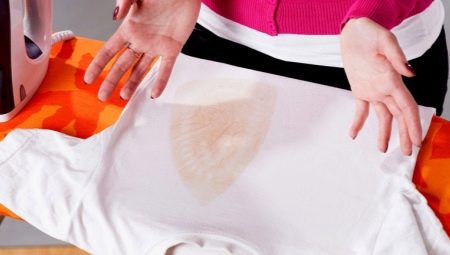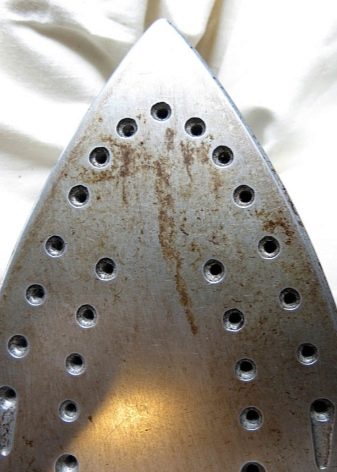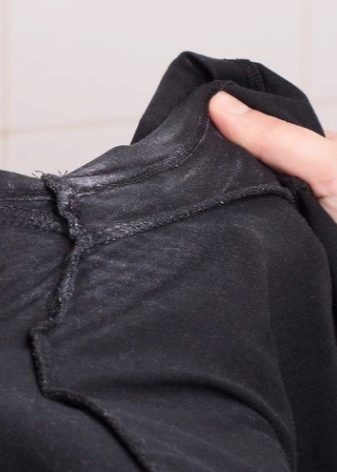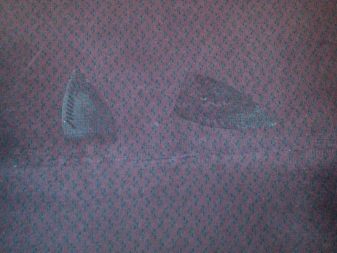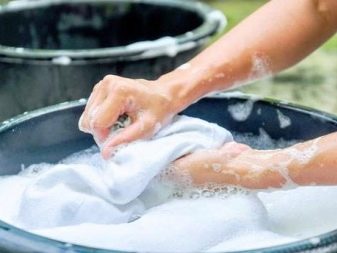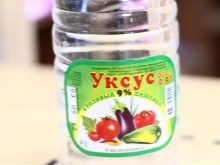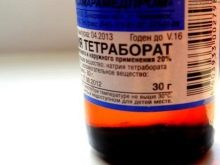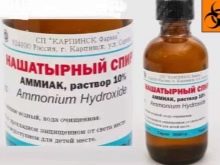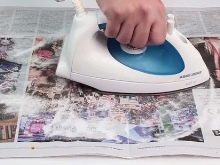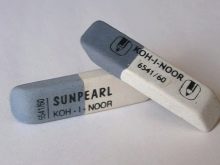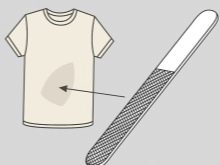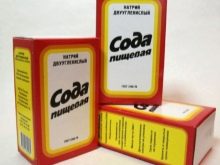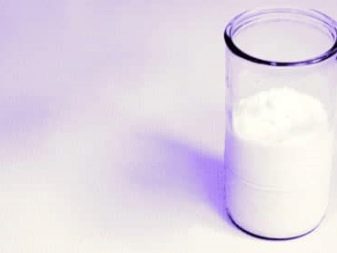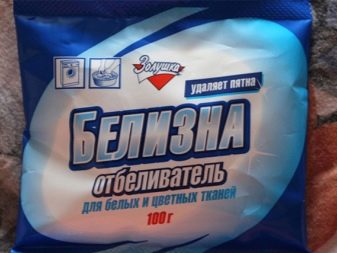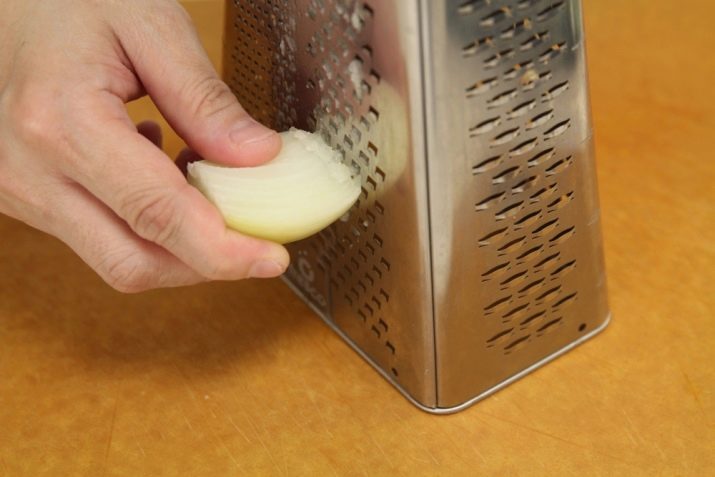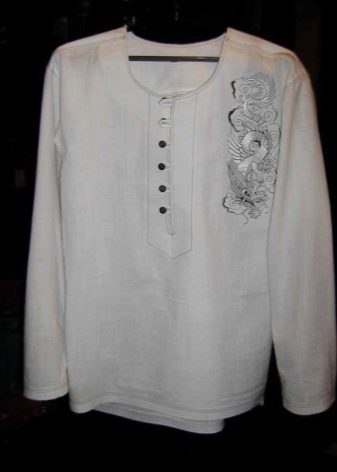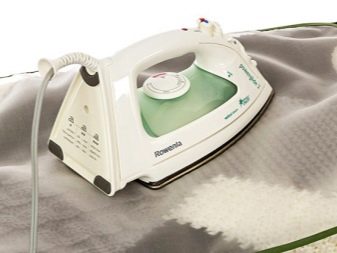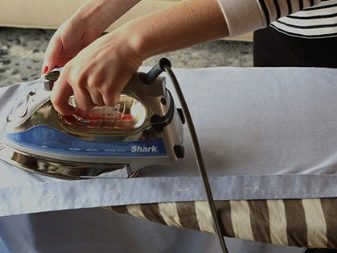If the temperature during ironing is not set correctly, then quite often unpleasant stains and yellow burns appear on clothes, bedding and rugs. However, this can happen because of the banal inattention. But if the hostess burned pants or shirt - this does not mean that the thing is completely spoiled, in most cases it can be saved and the original color of the clothes can be returned.
Causes of tanning
The main causes of tanning are the following:
- violation of the basic rules of heat treatment of things;
- illiterately selected ironing temperature of various types of fabrics;
- lack of care for the ironing surface of the iron and the board, which leads to contamination of products at the time of their ironing;
- insufficient rinsing of things — in this case, when a hot iron comes in contact with the remains of laundry detergent, the latter begin to “burn”, which causes the appearance of rather unaesthetic spots.
On the fabrics of black and dark shade most often appears gloss - shiny traces of hot iron on the surface of the material. On lighter linen, tanning marks are formed, they have a yellowish color and less often brown.
There is no universal recipe that allows you to remove stains from any things without a trace. Much depends on the type of fabric, the composition and thickness of the fabric. The “older” the stain, the more difficult it is to completely get rid of it. And, of course, if there is a brown spot in front of you, then it’s almost impossible to save such a thing - in this case, the fibers of the matter are damaged and there is no technical possibility to restore them.
How to effectively remove stains from the fabric?
Regardless of the reason for the iron mark on the canvas, the first thing to do is not to allow the particles of burnt fibers to penetrate deep into the material, so the thing must be immediately thoroughly washed under running water, then gently rub in the stain or any liquid detergent intended for washing and rinsed again.
Keep in mind that in this case the water should be cool, as hot, on the contrary, will contribute to further penetration of the spot into the material.
In some cases, such processing is sufficient, but more often, a number of additional measures should be taken to save the favorite thing.
Regardless of which method you choose, you first need to process the material in the inconspicuous area with a ready-made composition and wait a few minutes. If the fabric during this time is not corroded, and the color is not faded - you can safely use the selected drug.
Black
In order to remove stains from dark canvases, as a rule, borax, vinegar or alcohol are used.
Alcohol is optimal for the destruction of scorch on products made of viscose. To do this, the stain must be treated with alcohol and allowed to stand for about 60 minutes, then rinse thoroughly under cool running water.
Vinegar is used a little differently: they are moistened with a piece of cloth or a cotton pad and carefully wipe the contaminated place, leaving the smell until complete weathering. After this treatment, the product is ironed.
To use the borax solution, it is necessary to dilute 1 spoonful of the drug in a glass of water and then wipe the stain with this mixture. When the treated area is dry, you should wash the thing on the machine in standard mode.
Be sure to keep in mind that these options are used only for synthetic fabrics.
For satin or flax, there are a few other recipes. So, the shiny trail is well displayed by a mixture of salt and sal ammoniac (15 g each) dissolved in 2 liters of cold water. The fabric is treated, left for half an hour, then washed in warm water and gently ironed through gauze.
Vinegar can also be used for these tissues, but in this case it is diluted with water in a ratio of 1 to 1, in the resulting solution they soak a thin bright cloth, put it on the damaged area and gently iron it, while not strongly pressing the iron.
Laundry soap can also help in the fight with an ugly shine on black things. In this case, it is rubbed on a coarse grater, some ordinary water is added and dissolved, then it is used in the same way as in the case described above — a piece of gauze is soaked in solution and stroked through the damaged item.
Some housewives iron a shiny scorch across the newspaper — this also works, especially when it comes to black fabrics.
One of the fastest and most effective methods to remove the stain is the use of tea leaves. Tea must be loose, packaged here is not suitable. For processing, the damaged areas are treated with tea, and then they look with a hot iron.
In the fight against yellow scorches, tools such as sawing, pumice or even a razor can be a great help. Damaged areas gently “shave” or “saw off”, but try not to overdo it, otherwise you will easily get a hole.
If the matter is very delicate, you can try using a regular school eraser.
If a canvas of cotton and wool has suffered, then first try to save the thing by rubbing the soiled area with a damp cloth. If the footprint is small, then, quite possibly, it will come down.
If the tan is big or the thing is too expensive, then it makes sense to resort to dry cleaning services.
White
To remove the scorch marks from the white fabric is much more difficult. One of the most effective means is considered lemon juice. The damaged area is treated with juice, and then plentifully powdered with powdered sugar. As soon as the place of processing is dry, the item should be washed in cold water.
Hydrogen peroxide is distinguished by rather high efficiency, which is poured onto a clean cloth and gently wipe a soiled piece of cloth. After the treated stain dries, the product should be washed.
Baking soda can also be a good helper. The stain should be plentifully moistened, and then also plentifully sprinkled with soda. When it is completely absorbed into the material, the stain is rubbed with the hard side of the sponge, then rinsed thoroughly. The procedure can be repeated several times until the spot disappears completely.
Good result gives edible salt. The processing technique in this case is the same as with soda.
Some housewives use milk. They spill it on the stain and when it dries, the stain often disappears. With the same purpose quite often take yogurt or sour milk. It is diluted with water in the ratio of 1 to 2 and soaked soiled thing for several hours to completely eliminate the stain.
If the iron left deep stains on the white cloth, bleach can handle it.However, this tool is quite caustic, so when working you should wear gloves and a gauze bandage. To prepare a cleaning suspension, 5 g of bleach is diluted in a liter of heated water and the soiled thing is soaked in this solution for 5-7 minutes, then the product is straightened and the stain is poured with a concentrated solution of chlorine. In this view, the product is left for 15 minutes, then rinsed in a large volume of water.
It should be borne in mind that this option is used only for cotton fabrics, using it on artificial fabric and wool will simply damage the material even more.
Color
If the thing is colored, then you can use ordinary onions. It is rubbed on a grate, and the resulting gruel is applied to the contaminated area for 30-70 minutes, after which the item is rinsed. Instead of a slurry of grated onion, you can also use pressed juice - it is rubbed into the canvas, and the fibers of the material literally “push” the burner within half an hour.
Keep in mind that the smell of onions will erode for quite some time, so you may need several washes to get rid of this particular flavor.
There is one small “but” - the method is good only if the spot is fresh. When the scorch marks “decorate” a thing for quite a long time, it is hardly possible to save it.
What if a thing is burned?
Sometimes, after using the iron, dark brown or even black markings are left on the products. The reasons here can be forgetfulness of the hostess, incorrectly set processing mode of the canvas or dust trapped in the water tank that comes out with steam and soils things. And if in the latter case, to get rid of the stain, you only need to wash the fabric, then in the first and second it is almost impossible to remove the ugly stain. However, you can give the product a second life.
To get started, go over the stain with a toothbrush to completely get rid of burnt fibers. The spot can also be moistened with lemon juice, then rub the burner's nail file or with a sharp knife. Very well removes the damaged fiber machine for the pellets - all you need is just to walk it through the damaged area of matter.
Keep in mind that these options are good only for dense materials, since after removing the damaged layer other fibers will remain. If you burned the thing to the holes, then you can sew a patch or apply an original application to this place.
In stores that sell sewing accessories, there is a wide selection of appliqués of various shapes and shades, they can be made from a wide variety of fabrics and often look like embroidery. Most applications have an adhesive bottom layer with which they can be applied without using a needle with a thread.
Appliques are applied to cotton fabrics with the help of an iron. The surface to be treated should be cleaned from dirt, dust and debris. The place where the drawing is planned is carefully ironed and cooled. With the thermal patch removed the bottom layer, which protects the adhesive surface. It must be pressed to the canvas and covered with a hot iron for 5-7 minutes, after which the product should be ironed and the upper protective layer of the picture removed.
For soft and synthetic fabrics such options are unacceptable - here applications and patches can only be sewn on.
Precautionary measures
It does not matter if you have damaged some old unnecessary thing, but the scorching marks on the jackets, skirts or blouses deliver a lot of unpleasant moments to their hostesses. To minimize the risk of such damage, you should follow a few tips:
- when ironing things by all means use the ironing;
- if there is such an opportunity, then it is better to iron the product from the wrong side;
- ironing temperature should be set according to the type of material;
- after washing each product should be rinsed as best as possible;
- Watch the condition of the sole of the iron - it must be exceptionally clean, without soot and stuck objects.
Of course, the trace from the iron is much easier to display if it is fresh. That is why it is necessary to take drastic measures immediately, as soon as the stain appeared on the product. Any of the methods described above can help, but only if the work is done on time.
After buying a new thing, be sure to study its label; it is necessary to indicate the temperature at which it should be ironed. Typically, lower temperatures are established for synthetics, and elevated ones for jeans, flax and cotton.
If you have made a stain, by all means inspect the cooled sole of the iron - most likely, adhered burnt fibers of the material remained on it. They should be removed and the remaining stain cleaned, otherwise the iron will soil all things on subsequent ironings.
And, of course, you should not iron your favorite dress on the sofa or carpet - in this case, the spots are no longer correct.
How to remove iron marks on clothes, see the video below.
